CALF TRAINING FOR MASS: 4 TIPS TO BUILD SKINNY CALVES
There’s no question that building up naturally skinny calves can be quite a challenge for many trainees.
Aside from a couple of legitimate genetic disadvantages at play(Check out my previous post, “Why Calves Don’t Grow Easily” for a brief explanation of this), most guys also make several simple but crucial errors in their training form that make adding significant size to their calves next to impossible.
In this article I’m going to outline 4 very important tips that you should be applying to all of your standing calf raise movements (the #1 movement I recommend for optimal calf training) if you want to see the very best results possible.
Give these a try on your next workout and I guarantee you’ll notice a significant difference in how effectively you’re able to stimulate your calves…
Calf Training For Mass: Form Tip #1
Instead of driving yourself up onto the entire ball of your front foot, focus on raising yourself up onto your big toe instead.
This prevents your feet and ankles from rolling outward and maximally stimulates the inner portion of your calf where the largest percentage of the mass is located.
If you simply perform a regular calf raise without thinking about this, your body will naturally follow the path of least resistance and do the opposite, since your big toe is positioned furthest away.
Give this one a try and you should notice an immediate improvement in how intensely you’re able to contract your calves on each rep.
Calf Training For Mass: Form Tip #2
When most people perform standing calf raises, they place their feet at shoulder width apart or narrower throughout the exercise.
While this will certainly still work when it comes to stimulating the calves for growth, an even better approach is to go slightly wider at an inch or two outside of shoulder width.
Just like pressing yourself up onto your big toe, using a wider stance on your calf raises prevents your ankles from rolling outward as you press yourself up.
If you want to mix in some sets with a narrower stance that’s fine, but use the wider stance as the foundation of your calf training.
Calf Training For Mass: Form Tip #3
One very common and detrimental calf training mistake is in the excessive use of momentum.
In fact, it’s rare to see a lifter at the gym who doesn’t perform their calf raises in this way. The majority of people simply load up the weights and then “bounce” their way through the set by pumping out their reps without any real pause at the top or bottom of the movement.
When you “bounce” yourself out of the bottom position of a calf raise, you greatly minimize the amount of tension that is placed on the actual calf muscles and redirect it towards your achilles tendon instead.
The achilles tendon is an elastic tissue that connects the calves to the bottom of the foot. When you lower the resistance quickly, the achilles tendon gets loaded on the way down, and when you bounce out of the bottom position, you’re primarily using the elastic energy return potential of the tendon to raise yourself back up. As a result, a much smaller amount of actual muscular work ends up being involved.
The solution? Slow down your reps and stop using momentum.
Here’s what I’d recommend…
Pause in the very bottom position for a full 2 seconds… press yourself up as hard and fast as you can in proper form… pause in the fully contracted position for 1 second… and then lower yourself in 3-4 seconds.
This particular cadence will maximize the stress on your calves and minimize the involvement of the achilles tendon.
Calf Training For Mass: Form Tip #4
Keeping a very slight bend in your knees during standing calf raises is a good idea since it will take some of the stress off of your knee joints, however, the bend should be exactly that: very slight.
Bend your knees too much and you’ll be greatly reducing the effectiveness of your calf training by de-activating the gastrocnemius (the head of the calf where the vast majority of the muscle is located) and shifting the emphasis onto the much smaller and less significant soleus muscle that runs underneath.
Make sure to bend your knees just enough so that they aren’t completely locked out, but no further.
4 Tips For Building Skinny Calves: Quick Review
So, just to quickly recap the standing calf raise form tips we covered here…
1) As you press up, focus on raising yourself up onto your big toe rather than the entire front of your foot.
2) Stand with your feet positioned 1-2 inches outside of shoulder width.
3) Use the following rep cadence for the best results: press yourself up as hard and fast as you can in proper form… pause in the top position for 1 full second… lower yourself in 3-4 seconds… and pause in the bottom position for 2 seconds.
4) Keep only a very slight bend in your knees to take pressure off of your knee joints, but no further than this.
For a rundown of my top 5 recommended calf exercises along with some effective sample calf workouts, check out this previous post.
If you found these tips helpful, make sure to get your personalized training, nutrition and supplement plans using my free interactive video presentation below…

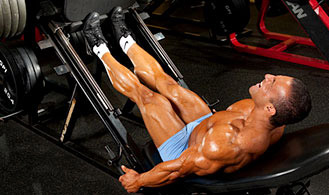
If you weren’t blessed with genetically muscular calves, adding significant size to this area of your physique can often be a challenge.
While some trainees seem to be able to gain mass just by looking at a calf raise machine, others can go years while experiencing only minimal progress.
In this article I’ll be outlining the 5 best calf exercises out there along with a few tips, tricks and sample calf workouts that you can start employing right away to finally begin seeing some measurable results…
Basic Calf Anatomy
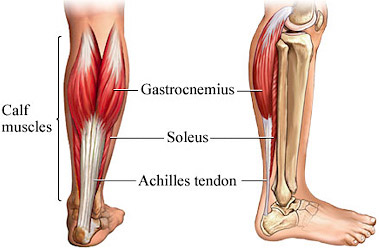
There are 2 individual heads that make up the complete calf muscle group…
Gastrocnemius – This is the major visible portion of the calf and is where the majority of your calf muscle mass resides. The function of the gastrocnemius is to elevate your heel when your knees are in a relatively straight position.
Soleus – This is the smaller portion of the calf that lies underneath the gastrocnemius. Its function is to elevate the heel when the knees are in a bent position.
Although both the gastrocnemius and soleus contribute to your overall calf development, the gastrocnemius is by far the most important head to pay attention to since it makes up the vast majority of the calf muscle.
Also keep in mind that the soleus will still be activated heavily during gastrocnemius-targeted exercises, while the gastrocnemius will not fire significantly during soleus-targeted exercises.
The 5 Best Calf Exercises
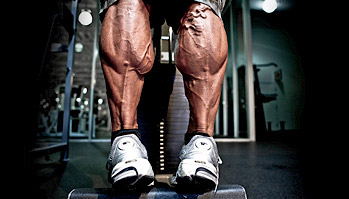
While there is a massive list of potential calf exercises that you could perform as part of your workout plan, there’s really no need to over-complicate things here.
Your goal should be to select exercises that allow you to place as much direct overload on the calf muscles as possible while minimizing the need to balance and coordinate the weight throughout the movement.
This is why machine exercises are generally superior, as they allow you to place 100% of your focus on generating maximum tension in the calves while handling a large amount of overall resistance.
Here are the 5 best calf exercises to place the majority of your focus on…
#1 – Standing Machine Calf Raises
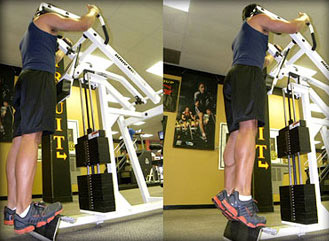
There’s really no way that you can go wrong with a basic standing machine calf raise. This exercise allows you to hammer your calves with a high level of intensity while keeping the weight completely steady and balanced for you.
Make sure to perform this lift with the largest range of motion possible by lowering yourself until your heels hang off the platform and raising yourself up until your heels are as high as possible.
As with all calf exercises, make sure to perform the exercise under strict control by utilizing a deliberate 3-4 second negative followed by a controlled positive with a brief pause at the top of the movement.
In order to generate maximum tension in the gastrocnemius, focus on raising yourself up onto your big toe rather than the entire ball of your foot. This prevents your foot from rolling outward and shifting the stress onto the soleus.
Click Here To View The Proper Form
#2 – Smith Machine Calf Raises
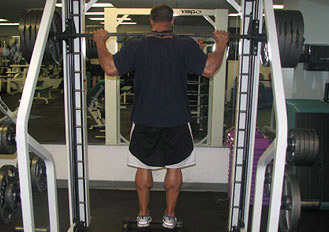
If your gym does not have a standing machine calf raise (or if you simply prefer this variation), performing your standing calf raises on a smith machine is also a great option.
The form should be executed in the same way here (3-4 second negative, pause at the top and raising up onto your big toe), but make sure to place a platform beneath your feet to allow for a full range of motion.
Click Here To View The Proper Form
#3 – One-Legged Dumbbell Calf Raises
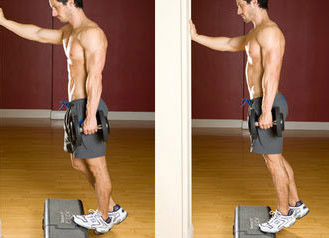
Another highly effective standing calf raise variation, this exercise is executed by holding a dumbbell in one hand and performing a one-legged calf raise on the corresponding leg.
Make sure to perform this exercise on a platform to allow for a full range of motion and hold onto a stationary object with your free hand to keep yourself balanced.
Although a freeweight exercise, it is fairly easy to train your calves with a high level of intensity since only one calf is being used to move the weight. This allows you to reach muscular failure with a fairly low amount of resistance.
The only downside to this exercise is that it is less efficient since you’ll have to perform twice as many sets.
Click Here To View The Proper Form
#4 – Leg Press Calf Raise
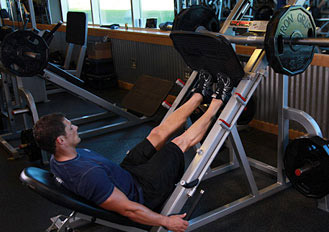
Another option for targeting the gastrocnemius is to perform your calf raises on a leg press machine.
Sit on the leg press machine and hold the sled in place using only the balls of your feet and your toes. Keep your hips and knees stationary and produce all of the movement through your ankles only.
The same basic technique should be applied here as well: a slow 3-4 second negative, controlled positive, full range of motion and pressing the sled using your big toe to maximize gastrocnemius activation.
Click Here To View The Proper Form
#5 – Seated Machine Calf Raises
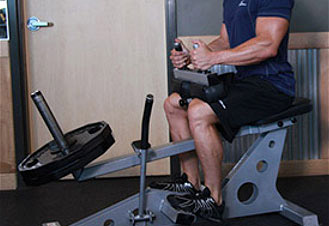
While the previous 4 exercises primarily target the gastrocnemius, the seated machine calf raise keeps the knees in a bent position to primarily stimulate the soleus.
Seated calf raises are not a mandatory exercise, but if you do decide to include them, make sure to do so at the very end of your calf workout.
The only difference in execution here is that you can raise up onto the entire ball of your foot rather than your big toe, since the soleus is the primary targeted head.
Click Here To View The Proper Form
Frequency, Sets & Reps

Because your calves are heavily utilized throughout your entire day to support your body weight as you walk around, they are a very “tough” muscle that can withstand and recover from a lot of abuse.
For that reason, there is no set-in-stone approach in terms of training frequency and number of sets performed. A lot of it will come down to you, your current calf development and how much training you can effectively recover from.
For most people, 2 calf workouts per week is a good starting point. If your calf development continues to lag even at that frequency, try bumping it up to 3 or even more calf workouts per week until you start seeing noticeable results.
An effective calf workout should utilize 2-3 basic exercises of 2-4 sets each. Again, you’ll have to play around with this and see what works best for you as an individual. My recommendation would be to select 2 gastrocnemius targeted exercises followed by 1 optional soleus targeted exercise.
In terms of reps, anywhere as low as 5 reps all the way up to 15 will produce results in the calves. The calves are a highly variable muscle group that respond well to a variety of different rep protocols.
However, since the gastrocnemius is primarily a fast-twitch muscle group, a “sweet spot” of around 5-7 reps is what I would recommend for standing calf raise movements.
The soleus, on the other hand, is primarily a slow-twitch muscle group, and 8-10 reps would be the ideal range I would suggest for seated calf raise movements.
Sample Calf Workouts
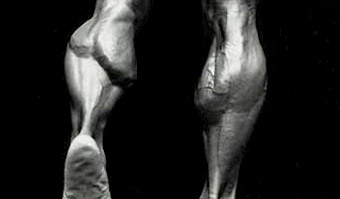
Putting all of this information together, here are a few sample calf workouts you can utilize as part of your training plan…
Sample Calf Workout #1
Standing Machine Calf Raise – 3-4 sets of 5-7 reps
Leg Press Machine Calf Raise – 3-4 sets of 5-7 reps
Seated Machine Calf Raise – 2-3 sets of 8-10 reps
Sample Calf Workout #2
Smith Machine Calf Raise – 3-4 sets of 5-7 reps
One-Legged Dumbbell Calf Raise – 3-4 sets of 5-7 reps
Seated Machine Calf Raise – 2-3 sets of 8-10 reps
Sample Calf Workout #3
Standing Machine Calf Raise – 3-4 sets of 5-7 reps
One-Legged Dumbbell Calf Raise – 3-4 sets of 5-7 reps
Sample Calf Workout #4
Leg Press Machine Calf Raise – 3-4 sets of 5-7 reps
Smith Machine Calf Raise – 3-4 sets of 5-7 reps
Again, these are just some ideas for you to play around with, as there are many different exercise, set, rep and frequency combinations that will work very well for the calves.
Just make sure to place 100% of your focus on training your calves with a high level of intensity (effective calf training should be very uncomfortable and challenging to perform) and increasing the amount of weight lifted on each exercise every week or two.
As long as you’re making use of the 5 calf exercises outlined in this article, employing the form tips mentioned and remaining consistent with your training, you should be experiencing steady, consistent gains in calf size and strength.
If you found these tips helpful, make sure to get your personalized training, nutrition and supplement plans using my free interactive video presentation below…



Aside from a couple of legitimate genetic disadvantages at play(Check out my previous post, “Why Calves Don’t Grow Easily” for a brief explanation of this), most guys also make several simple but crucial errors in their training form that make adding significant size to their calves next to impossible.
In this article I’m going to outline 4 very important tips that you should be applying to all of your standing calf raise movements (the #1 movement I recommend for optimal calf training) if you want to see the very best results possible.
Give these a try on your next workout and I guarantee you’ll notice a significant difference in how effectively you’re able to stimulate your calves…
Calf Training For Mass: Form Tip #1
Instead of driving yourself up onto the entire ball of your front foot, focus on raising yourself up onto your big toe instead.
This prevents your feet and ankles from rolling outward and maximally stimulates the inner portion of your calf where the largest percentage of the mass is located.
If you simply perform a regular calf raise without thinking about this, your body will naturally follow the path of least resistance and do the opposite, since your big toe is positioned furthest away.
Give this one a try and you should notice an immediate improvement in how intensely you’re able to contract your calves on each rep.
Calf Training For Mass: Form Tip #2
When most people perform standing calf raises, they place their feet at shoulder width apart or narrower throughout the exercise.
While this will certainly still work when it comes to stimulating the calves for growth, an even better approach is to go slightly wider at an inch or two outside of shoulder width.
Just like pressing yourself up onto your big toe, using a wider stance on your calf raises prevents your ankles from rolling outward as you press yourself up.
If you want to mix in some sets with a narrower stance that’s fine, but use the wider stance as the foundation of your calf training.
Calf Training For Mass: Form Tip #3
One very common and detrimental calf training mistake is in the excessive use of momentum.
In fact, it’s rare to see a lifter at the gym who doesn’t perform their calf raises in this way. The majority of people simply load up the weights and then “bounce” their way through the set by pumping out their reps without any real pause at the top or bottom of the movement.
When you “bounce” yourself out of the bottom position of a calf raise, you greatly minimize the amount of tension that is placed on the actual calf muscles and redirect it towards your achilles tendon instead.
The achilles tendon is an elastic tissue that connects the calves to the bottom of the foot. When you lower the resistance quickly, the achilles tendon gets loaded on the way down, and when you bounce out of the bottom position, you’re primarily using the elastic energy return potential of the tendon to raise yourself back up. As a result, a much smaller amount of actual muscular work ends up being involved.
The solution? Slow down your reps and stop using momentum.
Here’s what I’d recommend…
Pause in the very bottom position for a full 2 seconds… press yourself up as hard and fast as you can in proper form… pause in the fully contracted position for 1 second… and then lower yourself in 3-4 seconds.
This particular cadence will maximize the stress on your calves and minimize the involvement of the achilles tendon.
Calf Training For Mass: Form Tip #4
Keeping a very slight bend in your knees during standing calf raises is a good idea since it will take some of the stress off of your knee joints, however, the bend should be exactly that: very slight.
Bend your knees too much and you’ll be greatly reducing the effectiveness of your calf training by de-activating the gastrocnemius (the head of the calf where the vast majority of the muscle is located) and shifting the emphasis onto the much smaller and less significant soleus muscle that runs underneath.
Make sure to bend your knees just enough so that they aren’t completely locked out, but no further.
4 Tips For Building Skinny Calves: Quick Review
So, just to quickly recap the standing calf raise form tips we covered here…
1) As you press up, focus on raising yourself up onto your big toe rather than the entire front of your foot.
2) Stand with your feet positioned 1-2 inches outside of shoulder width.
3) Use the following rep cadence for the best results: press yourself up as hard and fast as you can in proper form… pause in the top position for 1 full second… lower yourself in 3-4 seconds… and pause in the bottom position for 2 seconds.
4) Keep only a very slight bend in your knees to take pressure off of your knee joints, but no further than this.
For a rundown of my top 5 recommended calf exercises along with some effective sample calf workouts, check out this previous post.
If you found these tips helpful, make sure to get your personalized training, nutrition and supplement plans using my free interactive video presentation below…

THE 5 BEST CALF EXERCISES FOR MASS + SAMPLE CALF WORKOUTS

If you weren’t blessed with genetically muscular calves, adding significant size to this area of your physique can often be a challenge.
While some trainees seem to be able to gain mass just by looking at a calf raise machine, others can go years while experiencing only minimal progress.
In this article I’ll be outlining the 5 best calf exercises out there along with a few tips, tricks and sample calf workouts that you can start employing right away to finally begin seeing some measurable results…
Basic Calf Anatomy

There are 2 individual heads that make up the complete calf muscle group…
Gastrocnemius – This is the major visible portion of the calf and is where the majority of your calf muscle mass resides. The function of the gastrocnemius is to elevate your heel when your knees are in a relatively straight position.
Soleus – This is the smaller portion of the calf that lies underneath the gastrocnemius. Its function is to elevate the heel when the knees are in a bent position.
Although both the gastrocnemius and soleus contribute to your overall calf development, the gastrocnemius is by far the most important head to pay attention to since it makes up the vast majority of the calf muscle.
Also keep in mind that the soleus will still be activated heavily during gastrocnemius-targeted exercises, while the gastrocnemius will not fire significantly during soleus-targeted exercises.
The 5 Best Calf Exercises

While there is a massive list of potential calf exercises that you could perform as part of your workout plan, there’s really no need to over-complicate things here.
Your goal should be to select exercises that allow you to place as much direct overload on the calf muscles as possible while minimizing the need to balance and coordinate the weight throughout the movement.
This is why machine exercises are generally superior, as they allow you to place 100% of your focus on generating maximum tension in the calves while handling a large amount of overall resistance.
Here are the 5 best calf exercises to place the majority of your focus on…
#1 – Standing Machine Calf Raises

There’s really no way that you can go wrong with a basic standing machine calf raise. This exercise allows you to hammer your calves with a high level of intensity while keeping the weight completely steady and balanced for you.
Make sure to perform this lift with the largest range of motion possible by lowering yourself until your heels hang off the platform and raising yourself up until your heels are as high as possible.
As with all calf exercises, make sure to perform the exercise under strict control by utilizing a deliberate 3-4 second negative followed by a controlled positive with a brief pause at the top of the movement.
In order to generate maximum tension in the gastrocnemius, focus on raising yourself up onto your big toe rather than the entire ball of your foot. This prevents your foot from rolling outward and shifting the stress onto the soleus.
Click Here To View The Proper Form
#2 – Smith Machine Calf Raises

If your gym does not have a standing machine calf raise (or if you simply prefer this variation), performing your standing calf raises on a smith machine is also a great option.
The form should be executed in the same way here (3-4 second negative, pause at the top and raising up onto your big toe), but make sure to place a platform beneath your feet to allow for a full range of motion.
Click Here To View The Proper Form
#3 – One-Legged Dumbbell Calf Raises

Another highly effective standing calf raise variation, this exercise is executed by holding a dumbbell in one hand and performing a one-legged calf raise on the corresponding leg.
Make sure to perform this exercise on a platform to allow for a full range of motion and hold onto a stationary object with your free hand to keep yourself balanced.
Although a freeweight exercise, it is fairly easy to train your calves with a high level of intensity since only one calf is being used to move the weight. This allows you to reach muscular failure with a fairly low amount of resistance.
The only downside to this exercise is that it is less efficient since you’ll have to perform twice as many sets.
Click Here To View The Proper Form
#4 – Leg Press Calf Raise

Another option for targeting the gastrocnemius is to perform your calf raises on a leg press machine.
Sit on the leg press machine and hold the sled in place using only the balls of your feet and your toes. Keep your hips and knees stationary and produce all of the movement through your ankles only.
The same basic technique should be applied here as well: a slow 3-4 second negative, controlled positive, full range of motion and pressing the sled using your big toe to maximize gastrocnemius activation.
Click Here To View The Proper Form
#5 – Seated Machine Calf Raises

While the previous 4 exercises primarily target the gastrocnemius, the seated machine calf raise keeps the knees in a bent position to primarily stimulate the soleus.
Seated calf raises are not a mandatory exercise, but if you do decide to include them, make sure to do so at the very end of your calf workout.
The only difference in execution here is that you can raise up onto the entire ball of your foot rather than your big toe, since the soleus is the primary targeted head.
Click Here To View The Proper Form
Frequency, Sets & Reps

Because your calves are heavily utilized throughout your entire day to support your body weight as you walk around, they are a very “tough” muscle that can withstand and recover from a lot of abuse.
For that reason, there is no set-in-stone approach in terms of training frequency and number of sets performed. A lot of it will come down to you, your current calf development and how much training you can effectively recover from.
For most people, 2 calf workouts per week is a good starting point. If your calf development continues to lag even at that frequency, try bumping it up to 3 or even more calf workouts per week until you start seeing noticeable results.
An effective calf workout should utilize 2-3 basic exercises of 2-4 sets each. Again, you’ll have to play around with this and see what works best for you as an individual. My recommendation would be to select 2 gastrocnemius targeted exercises followed by 1 optional soleus targeted exercise.
In terms of reps, anywhere as low as 5 reps all the way up to 15 will produce results in the calves. The calves are a highly variable muscle group that respond well to a variety of different rep protocols.
However, since the gastrocnemius is primarily a fast-twitch muscle group, a “sweet spot” of around 5-7 reps is what I would recommend for standing calf raise movements.
The soleus, on the other hand, is primarily a slow-twitch muscle group, and 8-10 reps would be the ideal range I would suggest for seated calf raise movements.
Sample Calf Workouts

Putting all of this information together, here are a few sample calf workouts you can utilize as part of your training plan…
Sample Calf Workout #1
Standing Machine Calf Raise – 3-4 sets of 5-7 reps
Leg Press Machine Calf Raise – 3-4 sets of 5-7 reps
Seated Machine Calf Raise – 2-3 sets of 8-10 reps
Sample Calf Workout #2
Smith Machine Calf Raise – 3-4 sets of 5-7 reps
One-Legged Dumbbell Calf Raise – 3-4 sets of 5-7 reps
Seated Machine Calf Raise – 2-3 sets of 8-10 reps
Sample Calf Workout #3
Standing Machine Calf Raise – 3-4 sets of 5-7 reps
One-Legged Dumbbell Calf Raise – 3-4 sets of 5-7 reps
Sample Calf Workout #4
Leg Press Machine Calf Raise – 3-4 sets of 5-7 reps
Smith Machine Calf Raise – 3-4 sets of 5-7 reps
Again, these are just some ideas for you to play around with, as there are many different exercise, set, rep and frequency combinations that will work very well for the calves.
Just make sure to place 100% of your focus on training your calves with a high level of intensity (effective calf training should be very uncomfortable and challenging to perform) and increasing the amount of weight lifted on each exercise every week or two.
As long as you’re making use of the 5 calf exercises outlined in this article, employing the form tips mentioned and remaining consistent with your training, you should be experiencing steady, consistent gains in calf size and strength.
If you found these tips helpful, make sure to get your personalized training, nutrition and supplement plans using my free interactive video presentation below…


| Here's What You're Getting... | |
12 detailed meal plans ranging from 1250 calories per day all the way up to 4000. Whether you're trying to build lean muscle or lose fat, you can be sure you'll find a plan that suits your needs.
|
|
Easy to follow instructions for selecting the proper meal plan based on your individual goals. Just plug in a few basic numbers and you'll immediately know your individual calorie level for optimizing your body composition. |
|
Exact calorie and macronutrient breakdown for each individual food item, meal and for the day as a whole. This completely removes the guesswork for you and makes modifying your plan simple and straightforward. |
|
Balanced mix of the best muscle building and fat burning food sources available. Each plan is based around high quality lean proteins, minimally refined carbohydrates and healthy fats to fuel your results as effectively as possible. |
|

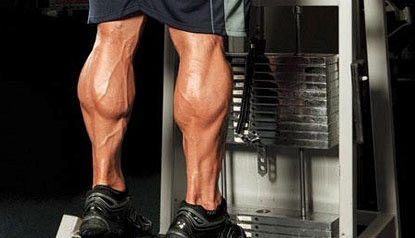
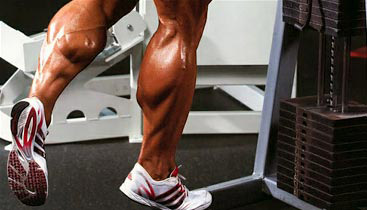









0 comments:
Post a Comment